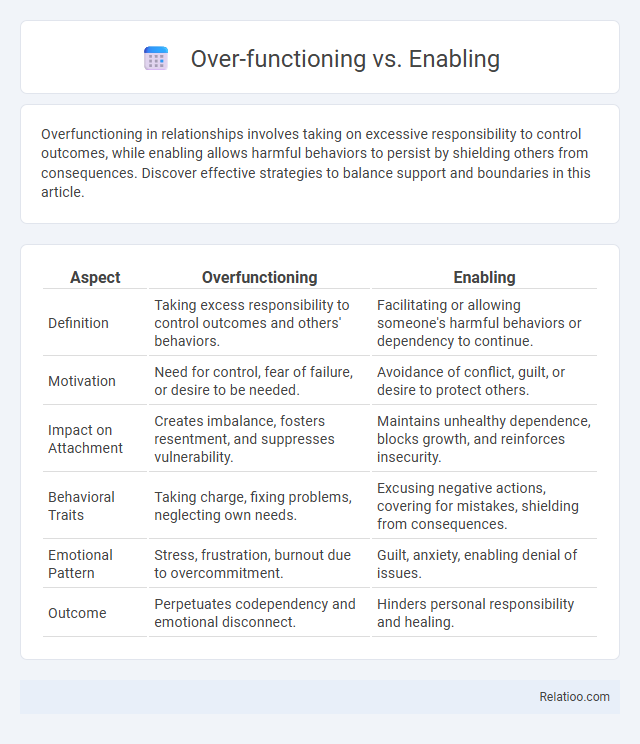Overfunctioning in relationships involves taking on excessive responsibility to control outcomes, while enabling allows harmful behaviors to persist by shielding others from consequences. Discover effective strategies to balance support and boundaries in this article.
Table of Comparison
| Aspect | Overfunctioning | Enabling |
|---|---|---|
| Definition | Taking excess responsibility to control outcomes and others' behaviors. | Facilitating or allowing someone's harmful behaviors or dependency to continue. |
| Motivation | Need for control, fear of failure, or desire to be needed. | Avoidance of conflict, guilt, or desire to protect others. |
| Impact on Attachment | Creates imbalance, fosters resentment, and suppresses vulnerability. | Maintains unhealthy dependence, blocks growth, and reinforces insecurity. |
| Behavioral Traits | Taking charge, fixing problems, neglecting own needs. | Excusing negative actions, covering for mistakes, shielding from consequences. |
| Emotional Pattern | Stress, frustration, burnout due to overcommitment. | Guilt, anxiety, enabling denial of issues. |
| Outcome | Perpetuates codependency and emotional disconnect. | Hinders personal responsibility and healing. |
Understanding Overfunctioning: Definition and Signs
Overfunctioning occurs when You consistently take on responsibilities beyond your role, often to compensate for others' lack of initiative, leading to burnout and imbalance. Key signs include chronic control, difficulty delegating tasks, and a tendency to solve others' problems at the expense of your own well-being. Recognizing these behaviors helps distinguish overfunctioning from enabling, where support unintentionally fosters dependency rather than autonomy.
What Is Enabling? Key Characteristics Explained
Enabling involves supporting another person's behavior in a way that prevents them from facing the natural consequences of their actions, often rooted in a desire to help or protect. Key characteristics include excessive rescuing, making excuses, and taking responsibility for someone else's problems, which can unintentionally promote dependence and hinder personal growth. Understanding enabling helps you recognize unhealthy patterns and foster more balanced, accountable relationships.
The Roots of Overfunctioning and Enabling Behaviors
Overfunctioning behaviors often stem from a deep-seated need for control and fear of vulnerability, while enabling typically arises from a desire to avoid conflict and maintain harmony. These patterns are rooted in family dynamics, past trauma, or learned coping mechanisms that influence how you manage responsibility and support others. Recognizing these origins can help you break unhealthy cycles and foster healthier boundaries in relationships.
Overfunctioning vs Enabling: Core Differences
Overfunctioning involves taking excessive responsibility for others' tasks or emotions, often leading to burnout and interference with others' growth. Enabling, in contrast, refers to behaviors that inadvertently support or sustain another person's dysfunctional habits or dependency, preventing accountability and recovery. The core difference lies in overfunctioning driving control out of a desire to fix, while enabling perpetuates dysfunction by removing consequences.
Psychological Impact on Both Parties
Overfunctioning often leads to stress and burnout for the helper while fostering dependency and low self-esteem in the receiver, creating an unhealthy dynamic. Enabling supports harmful behaviors by removing consequences, which can exacerbate underlying issues and undermine personal accountability. Understanding these patterns helps you recognize the psychological toll on both parties and encourages healthier, more balanced relationships.
Why Overfunctioning and Enabling Are Harmful
Overfunctioning and enabling behaviors undermine personal responsibility by creating dependency and preventing growth in others, leading to dysfunctional relationships and burnout. Overfunctioning often results in neglecting one's own needs while enabling supports harmful patterns by excusing detrimental behaviors. Both impede emotional resilience and long-term problem-solving, fostering codependency and limiting individual accountability.
Recognizing the Triggers in Relationships
Recognizing the triggers in relationships involves identifying patterns where overfunctioning leads you to take excessive responsibility, often resulting in enabling behaviors that prevent others from developing independence. These triggers commonly stem from underlying fears of abandonment or failure, which drive you to control or fix situations beyond your role. Becoming aware of these emotional cues allows for healthier boundaries and promotes balanced interactions between support and autonomy.
Breaking the Cycle: Steps Toward Healthy Boundaries
Breaking the cycle of overfunctioning and enabling requires setting clear, healthy boundaries that protect your well-being and promote mutual responsibility. Recognize patterns where you overstep or compensate for others, then practice saying no and delegating tasks to encourage accountability. Consistent self-awareness and open communication help transform enabling behaviors into supportive, balanced relationships.
Practical Strategies to Stop Overfunctioning and Enabling
Practical strategies to stop overfunctioning and enabling include setting clear boundaries, practicing assertive communication, and encouraging personal responsibility in others. You can reduce overfunctioning by prioritizing self-care and delegating tasks to foster independence in your relationships. Consistently reinforcing limits while supporting autonomy helps break cycles of enabling and promotes healthier dynamics.
Seeking Support: Resources and Professional Guidance
Seeking support is crucial in distinguishing overfunctioning from enabling behaviors, as professional guidance helps you establish healthy boundaries and develop balanced responsibility sharing. Resources such as therapy, support groups, and educational materials provide strategies to manage controlling tendencies and promote autonomy in relationships. Utilizing expert advice ensures your efforts support growth rather than dependency, enhancing emotional well-being for all involved.

Infographic: Overfunctioning vs Enabling
 relatioo.com
relatioo.com